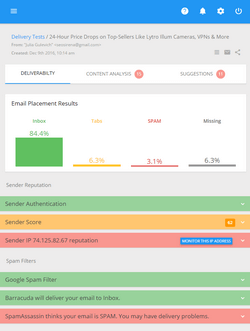Email Marketing Etiquette – 13 Best Email Practices
Email marketers can be divided into 3 categories: The Good, The Bad, and The Clueless. The “Bad” are crazy madcap-spammers. These geeks don’t care what kind of damage they’re doing. They send millions and millions of pieces of spam every day. They’re evil, and they know it.
The “Clueless” are much more common. They are generally good people who don’t mean any harm. They’re “just trying to get the word out.” They’re often decent business people, who have been in marketing and sales for years. But since they’re new to email marketing, they make all kinds of mistakes, and they typically have absolutely no idea what kind of mess they’re making. Don’t be a "clueless" email marketer.
“Good” email marketers know their etiquette and follow these email delivery guidelines:
- Number one rule of email marketing: obtain people’s permission before you email them. Since your recipients must pay for every email they receive (monthly ISP bills, bandwidth costs, etc.), permission is the foundation of “good” email marketing.
- Build your own mailing list. Don’t buy the lists of email addresses. They are full of bad addresses, and people who didn’t truly opt-in to receive anything from you. Good email marketers collect the email addresses on their own sites. Of course, this is a longer and harder way, but at least you are sure for 100% that everyone on the list actually wants to hear from you. Your response rate will be considerably higher, and since the list is smaller, the cost of delivery will be lower.
- Clear your list. Despite the fact you are using an opt-in method of collecting email addresses, it is reasonable to check the emails for validity before sending the message to the list. Some recipients can change their emails and forget to update their profile with you. Whether manually or using email verifier software, check for invalid and misspelled email addresses, invalid domains and typos. Also, make sure you won’t be sending to people who unsubscribed.
- Know the laws. Be sure to read and comply with the CAN-SPAM laws. Generally speaking, if your email is a marketing or sales type of message, you need to follow the rules, or you can be fined for each email sent.
- Don’t send too often. You risk making your customers tired of you. Send only when you gave something important to say. Think on your content and frequency. Will you be sending email newsletters every single week or month? What will be in the newsletter? Will the content of the message be relevant to the recipients’ expectations?
- Don’t let your permission “grow cold”. If you’ve been collecting the email addresses for years, and you’re only just now sending your first email to everyone, a little remind of how you got the recipient’s email address is nice. If you didn’t email your subscribers for a long time, people can forget what email lists they subscribed to. You can include a line like "You are receiving this email because you subscribed to our mailing list at www.glocksoft.com" in the Email Admin Center at the bottom or at the top (if appropriate) of your email.
- Never use an anonymous email address in the “Reply-to”, or in the unsubscribe link. Use your company domain, and be sure the emails to that address go to a live person.
- Don’t send complex email (Flash, Sounds, JavaScript, Videos, etc). Use HTML email wisely – not “just because you can”.
- Include a plain-text version of your newsletter together with the HTML part.
- Always provide an easy way to unsubscribe. You can provide an option to unsubscribe in the Email Admin Center area. If you don’t include the Email Admin Centre into the message, be sure to include an unsubscribe link somewhere at the bottom of the message.
- Check the content against a spam filter. It’s a good idea to test how your HTML newsletter will pass through an anti-spam filter. You can check the content of your message with a special program Lyris’ Content Checker. Lyris’ Content Checker will tell you how your newsletter ranks in Spam Assassin. You will know which words in your message trigger the anti-spam filter. You will be able to disguise or change those words or phrases.
- Test your newsletter. Send it to friends, family, and colleagues. Try the newsletter in as many different email applications as you can. Open your own emails, and click them like crazy. Now go check your reports. Make sure all the tracking works like it should. Hit the “reply” button and see if you get replies to your account. You want to uncover and correct any embarrassing mistakes before sending to your real customers.
- Don’t CC your entire list. Most of the time the newbie’s make the mistake of entering their entire customer’s list into the CC field of the email program. This method of delivery has some downsides: a) you reveal your entire list to all people within the list, this may not be acceptable for everyone; b) someone from your recipients can click "Reply to All" button by mistake and the reply addressed to you will be distributed to all of the group; c) CC doesn’t allow sending a personalized email message to each recipient. At least you can insert the greeting like "Dear Customer" but agree that it is not as friendly as "Dear John".
For a "good" email marketer, managing and improving email delivery must be of a great importance. A successful email campaign can reduce your email delivery costs and increase conversions or transactions.
Table of contents | Page list for this chapter | Next page

